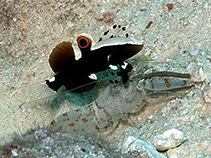| Family: |
Gobiidae (Gobies), subfamily: Gobiinae |
| Max. size: |
3.13 cm SL (male/unsexed) |
| Environment: |
reef-associated; marine; depth range 10 - 15 m |
| Distribution: |
Western Indian Ocean: Red Sea and adjacent areas. Elsewhere in the Indo-West Pacific refers to Lotilia klausewitzi. |
| Diagnosis: |
Dorsal spines (total): 7-7; Dorsal soft rays (total): 9-9; Anal spines: 1-9; Anal soft rays: 9; Vertebrae: 26-26. This species is distinguished by the following characters: no cephalic sensory canals and pores; sensory-papillae row 4i not extending ventrally beyond a horizontal line through posterior end of row d; right and left sides of row n are not close to one another, with a broad interspace between them; branched caudal-fin rays 7+7=14; pale area on dorsum from snout to dorsoanterior part of body is relatively long, extending posteriorly to around base of third or fourth spine; presence of a conspicuous ocellated black spot with vivid pale margin at center of first dorsal fin, extending anteriorly beyond third spine; absence of a submarginal row of black spots on caudal fin (Ref. 90832). |
| Biology: |
Found only on sandy areas, and symbiotically associates with a snapping shrimp, probably Alpheus djiboutensis where it swims freely at ca. 10-15 cm above the nest hole as it moves its pectoral fins alternately. It was also reported that, in the northern Red Sea, it is associated with an unidentified Alpheus species which is not A. djiboutensis (Ref. 90832). |
| IUCN Red List Status: |
Data deficient (DD); Date assessed: 27 August 2020 Ref. (130435)
|
| Threat to humans: |
harmless |
Source and more info: www.fishbase.org. For personal, classroom, and other internal use only. Not for publication.

